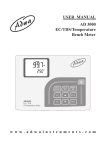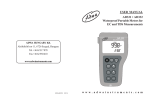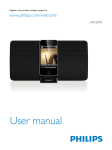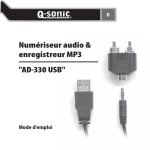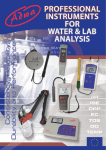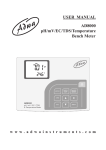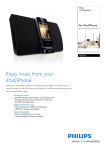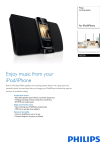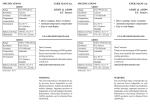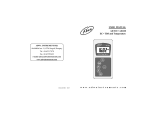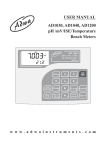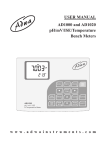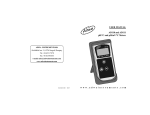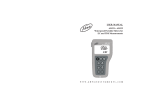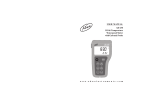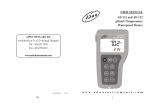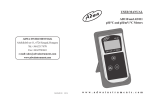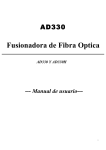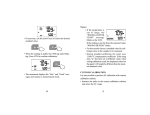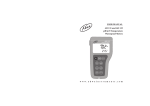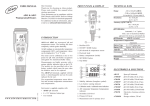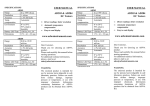Download USER MANUAL AD 330 EC/TDS/Temperature Portable Meter
Transcript
USER MANUAL AD 330 EC/TDS/Temperature Portable Meter w w w . a d w a i n s t r u m e n t s . c o m Dear Customer, Thank you for choosing an Adwa product. Please read carefully this manual before starting operations. This instrument is in compliance with the EMC directive 2004/ 108/EC and its standards, and Low Voltage Directive 2006/95/ EC and its standards for electrical equipments. For additional technical information, please e-mail us at [email protected]. WARRANTY Adwa warrants this product to be free of defects in material and workmanship as stated in the operating manual. If repair or adjustment is necessary and has not been the result of abuse, misuse or improper handling within the warranty period, please contact your dealer or nearest Adwa Office for the RGA (Return Goods Authorization) number to put on the outside of your package. Warranted service will be made without charge. The meter is warranted for a period of 2 years, while probes are warranted for 6 months. The warranty period commences from the original date of sale. Warranty is only valid when the product is used under normal conditions and in accordance with the instruction manual. The warranty is void if the instrument is repaired or serviced by unauthorized personnel, not used in accordance to the instructions, or if non-Adwa accessories such as buffer solutions, probes, etc. are used in conjunction with the meter. Adwa will not be held responsible for any accident whether directly or indirectly, caused by the use of this instrument. 2 TABLE OF CONTENTS Introduction ................................................................ 4 Technical Data .......................................................... 6 Front and Rear Panels .............................................. 8 Operational Guide .................................................... 10 Autoranging ............................................................. 13 Temperature Compensation .................................... 14 EC Calibration ......................................................... 16 Temperature Adjustment ........................................ 21 Setup ........................................................................ 22 Good Laboratory Practice ....................................... 25 Hold ......................................................................... 28 Battery Replacement .............................................. 29 Probe Maintenance ................................................. 30 Probes and Solutions ............................................... 31 3 INTRODUCTION AD330 is a heavy-duty portable microprocessor-based instrument for measuring conductivity, TDS and temperature. The autoranging feature of the EC and TDS readings automatically sets the instrument to the scale with the highest resolution. Measurements are compensated for temperature effect automatically (ATC) or manually (MTC). The temperature compensation feature can also be disabled to measure the actual conductivity. The temperature coefficient is user selectable. The instrument also features a measurement stability indicator, GLP capability, and a user selectable ID code to uniquely identify the instrument. 4 This model is supplied complete with: • AD76309 conductivity probe with built-in temperature sensor and 1 m cable • Calibration solution (20 ml sachet each): • 1413 μS/cm EC standard solution • 12,88 μS/cm EC standard solution • 1.5 V AA alkaline batteries (4 pcs) • User manual 5 TECHNICAL DATA Range 0.00 to 19.99 μS/cm; 0.00 to 9.99 ppm 20.0 to 199.9 μS/cm; 10.0 to 99.9 ppm 200 to 1999 μS/cm; 100 to 999 ppm 2.00 to 19.99 mS/cm; 1.00 to 9.99 ppt 20.0 to 199.9 mS/cm; 10.0 to 99.9 ppt -9.9 to 120.0 °C Resolution 0.01, 0.1, 1 μS/cm; ppm 0.01, 0.1 mS/cm; ppt 0.1 °C Accuracy ±1% f.s. (EC/TDS) (@25 °C/77 °F) ±0.5 °C EC Calibration Offset at 0.00 μS/cm; Slope at 1 point with 6 memorized values (84.0, 1413 μS/cm; 5.00, 12.88, 80.0, 111.8 mS/cm) or with custom value Temperature Automatic or manual, Compensation -9.9 to 120 °C Temperature User selectable Coefficient from 0.00 to 10.00%/°C TDS Factor User selectable from 0.40 to 1.00 (default value: 0.50) 6 Reference Temperature Selectable from 15.0 to 30.0 °C Probe (included) AD76309 EC probe with built-in temperature sensor Battery Type & Life 4x1.5 V AA (Alkaline batteries) approx. 200 hours of continuous use Auto-Off User selectable 5 minutes or disabled Environment 0 to 50 °C; RH max 95% non-condensing Dimensions 188 x 96 x 70 mm Weight 460 g 7 FRONT AND TOP PANELS 8 1. 2. 3. 4. Probe holder Connector for EC probe ON/OFF key, to turn the instrument ON and OFF HOLD/GLP key, to freeze the first stable reading on the LCD and to display Good Laboratory Practice information 5. CAL/SETUP key, to enter/exit calibration and setup modes 6. CFM key, to confirm values 7. SHIFT key, to activate the key alternate function Press and hold first the SHIFT key and then the second desired key 8. Down arrow key, to manually decrease the value of temperature or other parameters 9. Up arrow key, to manually increase the value of temperature or other parameters 10. RANGE/“lock” key, to select measurement unit or switch the focused data, and to freeze current range on the LCD 11. Secondary display 12. Primary display 9 OPERATIONAL GUIDE • The meter is supplied complete with four 1.5 V AA alkaline batteries. Remove the cover, unwrap the batteries and install them while paying attention to their polarity (also see “ Battery Replacement” section). • To prepare the instrument for use, connect the EC probe to the DIN connector. Tighten the threaded ring and make sure the probe sleeve is properly inserted. INSTRUMENT START-UP • Turn the instrument on by pressing the ON/OFF button. • At start-up the display will show all used segments for a few seconds (or while the button is held), followed by the reference temperature value with “rEF” indication, then enters the measurement mode. 10 • To save battery life, the auto-off feature automatically turns the meter off after 5 minutes with no button pressed. This feature can be disabled by entering the setup mode and selecting the “AoFF” item (see “Setup” section for details). TAKING MEASUREMENTS • Immerse the probe into the solution to be tested. The sleeve holes must be completely submerged. • Tap the probe repeatedly to remove any air bubbles that may be trapped inside the sleeve. • If needed, press RANGE until the desired EC or TDS range is displayed. • Allow for the reading to stabilize. The primary LCD will show the EC or TDS reading in the selected range, while the temperature is displayed on the secondary LCD. 11 Notes: • If the meter displays only dashes “----”, the reading • • • • is out of range. If the stability indicator (hourglass symbol) blinks, the reading is not stable. Make sure the meter is calibrated before taking measurements. If measurements are taken successively in different samples, for accurate reading it is recommended to rinse the probe thoroughly with deionized water before immersing it into the sample. TDS reading is obtained by multiplying the EC reading by the TDS factor, which has a default value of 0.50. It is possible to change the TDS factor within the 0.40 to 1.00 range by entering setup mode and selecting the “tdS” item (see “Setup” section for details). 12 AUTORANGING The EC and TDS scales are autoranging. The meter automatically sets the scale with the highest possible resolution. By pressing SHIFT and “lock” keys, the autoranging feature is disabled and the current range is frozen on the LCD. The μS, mS, ppm or ppt tag (depending on the selected measurement mode and range) starts blinking. To restore the autoranging option press the SHIFT and “lock” keys again. Note: Autoranging is automatically restored if range is changed, if setup or calibration mode is entered, or if meter is turned off and back on again. 13 TEMPERATURE COMPENSATION Three options are available for temperature compensation: 1. Automatic (ATC): the EC probe features a built-in temperature sensor, which provides the temperature reading to automatically compensate the EC/TDS measurement (from -9.9 to 120.0 °C), also using the selected reference temperature. 2. Manual (MTC): the temperature value can be manually set using the arrow keys. The compensation is referenced to the selected reference temperature. While in MTC mode, the °C tag blinks on the secondary LCD. 3. No compensation (NOTC): the temperature is not taken into account. The reading displayed on the primary LCD is the actual EC or TDS value. Notes: • The default compensation mode is ATC. • Temperature compensation setting can be accessed by entering the setup mode and selecting the “tcE” item (see “Setup” section for details). 14 • If the temperature compensation is active, measurements are compensated using the temperature coefficient (default value 1.90 %/°C). To change the temperature coefficient, enter the setup mode and select the “tc” item (see “Setup” section for details). • If the temperature reading is out of the -9.9 to 120.0 °C interval and the ATC option is selected, the temperature full scale value will be displayed, together with the °C tag blinking. • The reference temperature can be set from 15 to 30 °C. When the reference temperature is changed, the temperature coefficient must be manually adjusted by the user. For example, if α is the coefficient with reference temperature of 25 °C, if changing the temperature to 20 °C, the new coefficient can be calculated with the following formula: β=α/(1-α/20) If α=1.90%/°C, then β=2.10%/°C. • Always set reference temperature to 25 °C when measuring TDS. 15 EC CALIBRATION STANDARD CALIBRATION EC calibration is a one-point procedure. Selectable calibration points are: 0.00, 84.0 and 1413 μS/cm, 5.00, 12.88, 80.0 and 111.8 mS/cm. • Rinse the probe with calibration solution or deionized water, then immerse it into the solution. The sleeve holes must be completely submerged. • Tap the probe repeatedly to remove any air bubbles that may be trapped inside the sleeve. • To enter EC calibration, select the EC range and press CAL key. Note: TDS readings are automatically derived from the EC readings and no specific calibration for TDS is needed. Pressing CAL when TDS range is selected has no effect. • For zero calibration, simply leave the dry probe in the air. The “CAL” and “BUFFER” tags light up. 16 • The primary LCD displays the not calibrated EC reading, while the secondary LCD shows one of the available standard values. The hourglass symbol blinks. • If necessary, use the arrow keys to select the desired standard value. • When the reading is stable, the CFM tag starts blinking. Press CFM to confirm calibration. • The instrument displays the “Stor” and “Good” messages and returns to measurement mode. 17 Notes: • If the temperature is out of range, the “WRONG BUFFER TEMP” message blinks on the LCD. If the reading is too far from the expected value, “WRONG BUFFER” blinks. • For best results choose a standard value for calibration close to the sample to be measured. • During standard calibration the meter uses 1.90%/°C compensation coefficient. If the setup item “tc” has been set to different value, when exiting calibration mode, the displayed valued on the upper LCD might be different from the nominal standard value. CUSTOM CALIBRATION It is also possible to perform EC calibration with custom calibration solution. • Immerse the probe in the custom calibration solution and select the EC range. Press CAL to enter the EC calibration and then the RANGE key to enter custom EC calibration mode. 18 • The “CAL”, “BUFFER” and “Cal Point Custom” tags light up. The primary LCD displays the not calibrated temperature compensated EC reading, while the secondary LCD shows the temperature compensated EC reading, factory calibrated with (cell value) k=1. The hourglass symbol blinks. • Using the arrow keys, adjust the EC reading on the primary LCD to the desired value. • The maximum adjustment is ± 40% around the secondary LCD reading. • When the reading is stable, the CFM tag starts blinking on the LCD. Press CFM to confirm calibration. • The instrument displays the “Stor” and “Good” messages and returns to measurement mode. 19 Notes: • Zero calibration is not allowed in custom mode. • The calibrated custom value is considered the value of the calibration solution at the selected reference temperature. • It is possible to set the cell constant value directly, without following the calibration procedure. To set the cell constant enter the setup mode and select the “CELL” item (see “Setup” section for details). • The temperature reading is not used during custom EC calibration. 20 TEMPERATURE ADJUSTMENT The temperature reading can be manually fine-tuned following the next procedure. Press SHIFT and CFM keys to enter the temperature adjustment mode. Both primary and secondary LCDs will display the current temperature reading for a few seconds followed by the factory default temperature reading. Adjust the temperature reading on the primary LCD using the arrow keys. The maximum adjustment is ± 1.0 ºC around current reading. Press CFM to confirm. The meter returns to measurement mode and displays the new temperature. Notes: • Press SHIFT and CFM keys to escape without any changes. • To enter temperature adjustment mode, the probe must be connected and the meter must be in ATC mode. 21 SETUP Setup mode allows to view and modify the instrument parameters. To enter setup mode, press SHIFT and then SETUP key from measurement mode. The SETUP tag lights up. The primary LCD will display the temperature coefficient (default value 1.90%/ºC), while the secondary LCD shows the code of the current setup item. Select the desired setup item using the arrow keys, then press CFM to select and edit the setup item value, and its current value starts blinking (if it is a changeable parameter). 22 Press the arrow keys to change the value. If there is another part of the item to be set (e.g. month in setting up the current date), press RANGE and the part to be changed will start blinking. Press the arrow keys to change the value and CFM to confirm. Note: Press SHIFT and then SETUP key before confirmation to escape without changing the previously set value. 23 The following table lists the setup items, their valid range and the factory settings (default): Item Description Valid values tc Temperature coefficient 0.00 to 10.00% / ºC tcE Temp. compensation mode Atc, Mtc, notc Atc Reference temperature 15.0 to 30.0 ºC 25.0 ºC TDS factor 0.40 to 1.00 0.50 rEF tdS Default 1.90 CELL Cell constant (K) 0.500 to 1.700 AOFF Auto-off enable On, Off YEAr Year 2000 to 2098 DATE Date (DD.MM) 01.01 to 31.12 01.01 TIME Time (hh:mm) 01:01 to 23:59 00.00 0000 to 9999 0000 id Meter identification code vEr Firmware release 24 1.000 Off 2000 GOOD LABORATORY PRACTICE Good Laboratory Practice (GLP) is a set of functions that allows storage and retrieval of data regarding the status of the system. After a successful calibration, the meter automatically stores the date and time of calibration, the used calibration solution and the resulting cell constant value. All this information can be recalled by the user. To view the last calibration data, press SHIFT and then GLP keys. The first information appearing on the LCD is the meter "id" code. By repeatedly pressing RANGE key, all GLP data are displayed as shown in the next page: 25 Last calibration date (day and month): Last calibration date (year): Last calibration time: Cell constant (K): If standard calibration solution was used: If custom calibration solution was used: 26 If the cell constant was changed after calibration (through the “CELL” setup function), this information is not displayed. If RANGE is pressed when the last parameter is displayed, the meter returns to measurement mode. Notes: • To exit GLP mode at any time press SHIFT+GLP keys. • If the calibration procedure was never performed, after displaying the ID code, the LCD will show the “no CAL” message blinking. Press RANGE or SHIFT and GLP keys to return to measurement mode. • Last calibration data is available for EC range only. No calibration data can be recalled for TDS. If the meter is in TDS mode, by pressing SHIFT and GLP keys only the ID code is shown. Press SHIFT and GLP keys again to return to measurement mode. • GLP data are not affected by the zero calibration. 27 HOLD FUNCTION To freeze the first stable reading on the LCD, press the HOLD key from measurement mode. The “Auto” and “ H” tags will blink on the LCD until the reading is stabilized. When the reading becomes stable, the “Auto” and “H” tags stop blinking and the reading is frozen. Press the HOLD key again to return to normal measurement mode. 28 BATTERY REPLACEMENT When the batteries become too weak, the “bAtt” message appears on the secondary LCD. It is recommended to replace the batteries soon. When the battery level is too low to ensure reliable readings, the meter automatically turns off. Battery replacement must only take place in a safe area and using the battery type specified in this instruction manual. To replace rundown batteries, remove the battery cover and substitute all four 1.5 V AA alkaline batteries with new ones, while paying attention to the correct polarity. Reattach and tighten the battery cover making sure that the gasket is in place. Note: When batteries are removed, the meter can remember date & time for about 5 minutes. After that, it will be necessary to set again date & time through the setup procedure. 29 PROBE MAINTENANCE After measurements, rinse the probe with clean water. If a more thorough cleaning is required, remove the probe sleeve and clean the probe with a cloth or a non-abrasive detergent. Make sure to reinsert the sleeve onto the probe properly and in the right direction. After cleaning the probe, recalibrate the instrument. 30 PROBES AND SOLUTIONS AD76309 Conductivity probe with built-in temperature sensor and 1 m cable AD70030P 12.88 mS/cm EC standard solution, 20 ml sachet, 25 pcs. AD7030 12.88 mS/cm EC standard solution, 230 ml bottle AD70031P 1413 μS/cm EC standard solution, 20 ml sachet, 25 pcs. AD7031 1413 μS/cm EC standard solution, 230 ml bottle AD7033 84 μS/cm EC standard solution, 230 ml bottle AD7035 111.8 mS/cm EC standard solution, 230 ml bottle AD7034 80.00 mS/cm EC standard solution, 230 ml bottle AD7039 5000 μS/cm EC standard solution, 230 ml bottle AD70442P 1500 ppm TDS standard solution, 20 ml sachet, 25 pcs. AD70442 1500 ppm TDS standard solution, 230 ml bottle 31 ADWA HUNGARY Kft. Alsókikötõ sor 11, 6726 Szeged, Hungary Tel. +36 62 317 878 Fax +36 62 550 610 www.adwainstruments.com MANAD330 09/14
































